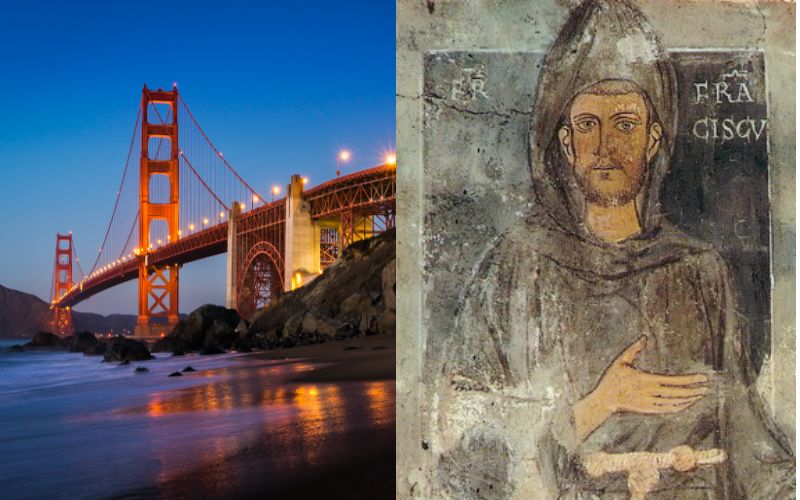San Francesco, CA. San Antonio, TX. St. Paul, MN.
These major American cities all have one thing in common: they’re named after some of the greatest Catholic saints.
It might seem strange that there are so many cities around the U.S. named after Catholic saints given American culture’s increasingly hostile posture toward important tenets of Catholicism. But maybe knowing about their saints can inspire a revival!
Here are bios of the hardcore Catholic saints behind the names of 6 American cities (plus a bonus one at the end!):
[See also: The Haunting Stories of 5 Saints Who Battled Demons]
[See also: 5 Saints Who Totally Had Superpowers]
1) San Francisco, CA

It’s a bit ironic that San Francisco, CA has become known for its acceptance of a wide range of sexual immorality, given that it’s named after one of the most fiery medieval preaches of repentance.
The 13th century Italian St. Francis of Assisi wasn’t an eco-hippy who just wanted to get along with everyone. Rather, he radically committed his whole life to following Christ and preaching the Gospel to anyone who would listen.
He traveled throughout Europe, calling on people to turn from their sins and seek forgiveness in the Sacrament of Reconciliation. He was a strong defender of the papacy and was particularly concerned with priests handling the Eucharist with appropriate reverence at Mass.
Others were inspired to follow him, and eventually he founded the Order of Friars Minor (the Lesser Brothers), also known as the Franciscans.
2) San Antonio, TX

San Antonio, TX is named after St. Anthony of Padua, a 13th century priest who was one of the first followers of St. Francis of Assisi.
He was also known for his fiery preaching of the Gospel and commitment to the Catholic Church. He was also a great theologian, with a particularly impressive command of Scripture. He lived such a holy life that he was canonized a saint within a year of his death (the second fastest saint to be canonized), and his theological writings have had such an impact on the Church that he is honored today as a Doctor of the Church.
3) Cupertino, CA

Cupertino, CA is home to one of the world’s most valuable companies, Apple. It got its name from a nearby creek called Arroyo San José de Cupertino, which in turn was named after St. Joseph of Cupertino.
St. Joseph of Cupertino was a 17th century Italian Franciscan brother. Despite a developmental disability, he had a deep, if simple, devotion to Christ. He had such a love for Christ that he was often fall into a religious ecstasy at Mass or even upon hearing Christ’s name, and apparently he would frequently levitate.
Yes, levitate. In front of large groups of people. Regularly.
He involuntarily levitated so often that it actually became a problem for his monastery. Word spread of his unique gift and the monastery was inundated with pilgrims. His religious superiors tried to calm the hysteria first by not letting him go out in public, and then by transferring him to other monasteries.
Today, he’s the patron saint of aviation, astronauts, mental handicaps, and students.
4) Santa Monica, CA

Santa Monica, CA is named for St. Monica, a 4th century saint best known for being the mother of St. Augustine. St. Augustine lived a life of immorality, pursing various pagan philosophies. But St. Monica kept praying that God would one day lead him to redemption in Jesus Christ in the Catholic Church.
By the grace of God, Augustine converted to Christianity at age 31, and went on to be not only a bishop, but also one of the greatest Christian theologians in history.
St. Monica is the patron saint of difficult marriages and the conversion of relatives.
5) St. Paul, MN

St. Paul, MN is of course named for St. Paul the Apostle.
At first a zealous persecutor of Christians, Jesus himself appeared to Paul and his life was changed forever. He dedicated his life to preaching the Gospel, particularly to gentiles. He traveled the Roman empire and suffered terrible persecution. He also wrote a number of letters to various churches which now make up a big chunk of the New Testament. He was martyred around A.D. 67 in Rome.
6) San Diego, CA

“Diego” is the Spanish version of “James,” so you might think San Diego is named after one of the Apostles with that name.
Nope. San Diego, CA is named after a fairly obscure saint, St. Diego de San Nicolás, also known as St. Didacus of Alcalá. His parents named him Didacus at birth, but called him Diego.
St. Diego was a 15th century Franciscan who lived a holy life from the time he was young. Even as a child, he wanted to be a hermit and placed himself under the direction of a local hermit. After living as a wandering hermit for a few years, he felt called to join the Franciscans.
He traveled throughout Spain preaching the Gospel for a while, but was eventually sent as a missionary to the Canary Islands. A few years later, he was recalled to Europe, and he spent the rest of his life in Spain. After he died, his body apparently remained incorrupt.
Bonus: Sacramento, CA

Sacramento, CA was named after the Sacramento River, which in turn was named for the Holy Sacrament, aka the Eucharist.
[See also: 15 Spectacular Monstrances for Our Lord in the Eucharist]
[See also: 22 Beautiful Altars Worthy of the Sacrifice of the Mass]

